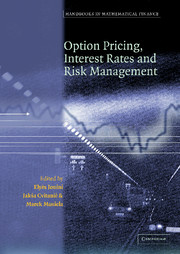Book contents
- Frontmatter
- Contents
- List of Contributors
- Introduction
- Part one Option Pricing: Theory and Practice
- Part two Interest Rate Modeling
- Part three Risk Management and Hedging
- 11 Credit Risk Modelling: Intensity Based Approach
- 12 Towards a Theory of Volatility Trading
- 13 Shortfall Risk in Long-Term Hedging with Short-Term Futures Contracts
- 14 Numerical Comparison of Local Risk-Minimisation and Mean-Variance Hedging
- 15 A Guided Tour through Quadratic Hedging Approaches
- Part four Utility Maximization
13 - Shortfall Risk in Long-Term Hedging with Short-Term Futures Contracts
from Part three - Risk Management and Hedging
Published online by Cambridge University Press: 29 January 2010
- Frontmatter
- Contents
- List of Contributors
- Introduction
- Part one Option Pricing: Theory and Practice
- Part two Interest Rate Modeling
- Part three Risk Management and Hedging
- 11 Credit Risk Modelling: Intensity Based Approach
- 12 Towards a Theory of Volatility Trading
- 13 Shortfall Risk in Long-Term Hedging with Short-Term Futures Contracts
- 14 Numerical Comparison of Local Risk-Minimisation and Mean-Variance Hedging
- 15 A Guided Tour through Quadratic Hedging Approaches
- Part four Utility Maximization
Summary
Introduction
Consider a firm with a commitment to deliver a fixed quantity of oil at a specified date T in the future. The commitment exposes the firm to the price of oil at time T. Suppose the firm buys futures contracts for an equal quantity of oil and for settlement at the same date T. In so doing, it has eliminated its exposure to the price of oil at T, but has it entirely eliminated its risk? If the futures contracts are marked-to-market - requiring, in particular, that the firm make payments should the futures price drop - but the forward commitment is not, then in eliminating its price exposure at time T the firm has potentially increased the risk of a cash shortfall before time T because of the funding requirements of the hedge. The possibility of an increased risk is even clearer if the original horizon T is long (say five years) but the futures contracts have a short maturity (say one month). The firm may seek to hedge the long -dated commitment through a sequence of short-term contracts, but this exposes the firm to price risk each time one contract is settled and the next is opened. In particular, should the price of oil decrease, funding the hedge will require infusions of additional cash.
The purpose of this chapter is to propose and illustrate a simple measure of the risk of a cash shortfall arising from the funding requirements of a futures hedge. We give particular attention to the probability of a large shortfall anytime up to a specified horizon as opposed to merely at that horizon.
- Type
- Chapter
- Information
- Handbooks in Mathematical FinanceOption Pricing, Interest Rates and Risk Management, pp. 477 - 508Publisher: Cambridge University PressPrint publication year: 2001
- 3
- Cited by



